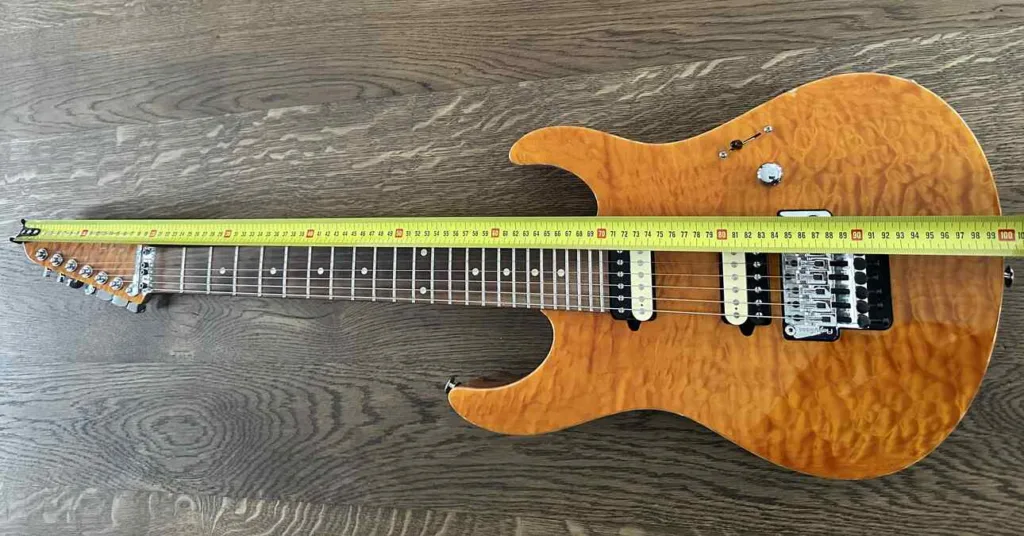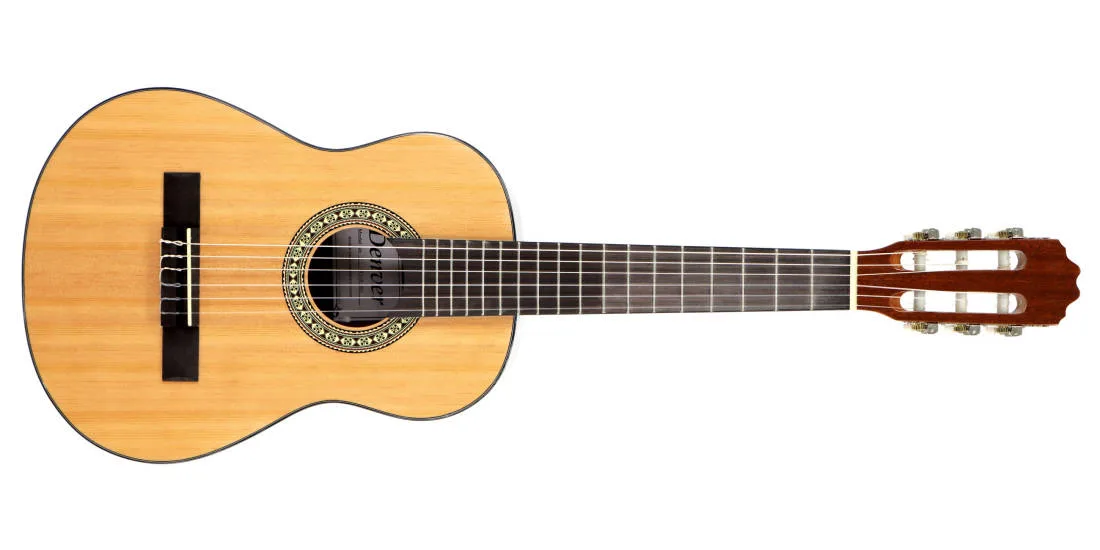Are you wondering, how long is a guitar? As a music enthusiast and guitarist myself, I know the importance of understanding all aspects of your instrument. From sound to size, every detail can make a difference in your playing experience. And when it comes to guitars, this often starts with the length- but what does that really mean?
In this article, we will delve into the surprising answer to the question “how long is a guitar?” We’ll cover everything from standard measurements to different types of guitars and their respective lengths. Whether you’re a beginner looking for your first guitar or an experienced player wanting to expand your collection, this article will provide valuable insight into the world of guitar lengths. So let’s get started and find out just how long these beloved instruments really are!
So, how long is a guitar?
The length of a guitar can vary depending on the type and size. Acoustic guitars typically range from 38-41 inches in length, while electric guitars are usually around 35-36 inches long. However, there are also smaller versions such as travel or mini guitars that can be as short as 28 inches. The surprising part is that the actual measurement of a guitar’s length is not just determined by its body, but also includes the neck and headstock. So when measuring a guitar, it’s important to take into account all these components for an accurate answer.
Guitars have been around for centuries and come in various shapes and sizes, each with their own unique sound. From classical to rock music, this versatile instrument has captured the hearts of many musicians and continues to evolve with modern technology.
So whether you’re strumming away on your acoustic or shredding on your electric guitar, knowing its length may seem like a trivial fact but adds to our understanding and appreciation of this beloved instrument. Plus, it’s always fun to impress your friends with some cool guitar trivia!
Understanding Guitar Length: The Basics
When you pick up a guitar, one of the first things to notice is its length. This measurement can significantly affect how the instrument feels and sounds. Guitars come in various sizes, from tiny travel guitars to full-sized acoustics and electrics. Generally, longer guitars have a larger body and wider fretboards, making them suitable for players with bigger hands or those who enjoy playing complex chords. On the flip side, shorter instruments can be easier for beginners or younger musicians to manage.
The scale length of a guitar—typically measured from the nut (the top part of the neck) to the saddle (where strings rest on the bridge)—also plays an essential role in its tone. A longer scale length provides more tension on each string, which often leads to brighter sound quality and enhanced projection. Conversely, shorter scales create softer tones that many find warm and inviting. Choosing between these options depends on what feels comfortable for you as a player; if you’re just starting out or considering switching instruments, experimenting with different lengths might help discover your unique style!
Read also: 2×12 guitar cabinet vertical
Different Types of Guitars and Their Respective Lengths
Guitars come in a delightful variety of shapes and sizes, each designed to suit different styles of music and playing preferences. Acoustic guitars are often the first choice for beginners due to their rich sound and straightforward use. They typically range from about 38 inches for smaller models, like travel guitars, up to 41 inches for larger dreadnoughts that provide a fuller tone. Then we have electric guitars, which can vary even more widely in length—from around 36 inches for compact designs to over 42 inches for those with extended necks meant for intricate solos. The size and shape of the guitar not only affect its portability but also its overall sound quality.
In addition to acoustic and electric models, there are bass guitars worth mentioning too! These usually measure between 43 and 45 inches long but feature four thicker strings tuned an octave lower than standard guitars. This unique design gives them a vital role in providing rhythm alongside melody. Moreover, specialized types like classical guitars are generally around 39-40 inches long; they boast nylon strings that offer a softer touch ideal for fingerpicking styles. Each type plays beautifully into various genres—be it rock or folk—proving there’s always a perfect fit when it comes to finding your musical voice!

Factors That Influence the Length of a Guitar
When it comes to the length of a guitar, several factors come into play. One of the most important is the type of music it’s meant for. For instance, electric guitars often have shorter scales, resulting in easier playability for fast solos and intricate riffs. In contrast, acoustic guitars typically feature longer scales that provide deeper resonance and richer sound quality—perfect for strumming chords in a folk setting. The scale length, which measures from the nut to the saddle on the bridge, can greatly affect how strings vibrate and ultimately influence tone.
Another factor to consider is player comfort and style. A guitarist’s height or hand size can determine whether they prefer a short or long instrument; smaller players might lean towards compact models that are more manageable while larger musicians may find full-sized guitars suitable. Additionally, tonal preferences also vary among guitarists—some seek out bright sounds from shorter lengths while others favor warm notes achievable through longer ones. Furthermore, materials used in construction impact overall performance as well; dense woods can contribute to sustain regardless of length but may alter how sound travels through the body.
All these elements combine to create unique instruments tailored for different experiences!
Implications of Guitar Length on Playing Experience
The length of a guitar can significantly influence how it feels to play and how music sounds. A longer guitar usually has a larger body, which can produce deeper, richer tones. This richness is especially noticeable in acoustic guitars, where the size contributes to volume and resonance. On the flip side, shorter guitars may feel more comfortable for smaller players or those just starting out. With their compact bodies and manageable neck lengths, they make it easier to reach all the frets without straining.
Another factor to consider is scale length—how far apart the frets are on the neck affects string tension and playability. For instance, electric guitars often have shorter scales that allow for easier bending of notes, while classical guitars tend toward longer scales that offer greater projection but may require more finger strength.
When musicians choose a guitar based on its length, they’re not just picking an instrument; they’re selecting a unique playing experience tailored to their needs.
- A longer scale might appeal to players who enjoy complex solos.
- A shorter scale could be perfect for strumming simpler chords.
- Body shape also plays into comfort during long practice sessions.
Ultimately, understanding these implications helps artists connect with their instrument on a personal level—leading them toward musical expression that truly resonates with who they are.
You may also like: Why is Taylor guitar so expensive
Conclusion: How Understanding Your Instrument’s Size Can Enhance Your Music Journey
When diving into the world of music, one important aspect often overlooked is the size of your instrument. Whether it’s a guitar, piano, or even a violin, each instrument comes in various sizes that can significantly affect how you play and sound. For instance, if you’re just starting with the guitar, choosing a smaller sized model might make it easier to hold and strum. This can lead to more enjoyable practice sessions where you feel comfortable exploring different chords and melodies without frustration. The right fit allows for freedom of movement and helps develop good habits early on.
Additionally, understanding your instrument’s size can enhance your performances as well. A well-fitted instrument resonates better and aligns with your unique playing style. For example:
- A larger piano may produce richer tones suitable for concerts.
- Smaller violins are perfect for younger players who need manageable weight.
- Guitars designed for small hands help foster confidence in beginners.
By selecting an instrument that feels just right in your hands, you’re not only facilitating smoother learning but also nurturing a deeper connection to the music itself. Ultimately, this awareness transforms every note played into a joyful experience!

